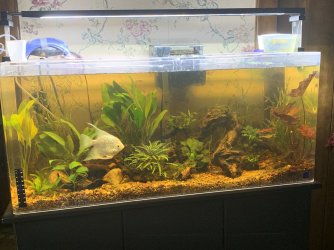Deeznuts
New Member
Hey guys, I’ve tried to look online, and I’m getting a lot of contradicting advice, considering the variables depending on the fish I’m interested in.
I have a 180-litre tank but only have 160 litres of water. I have a 200 Eheim pick-up filter and 200-watt heater to make up for heat loss through the open-top aquarium.
I currently have some starter platys. 6 in total.
I'm looking to get 2 common bristle nose plecos for a clean-up crew.
I have been advised barbs would be a nice edition as they'd match the platy's speediness and their water hardness preference levels. I naturally have hard water where I live.
I would like to get two dwarf cichlids but I know with standard size cichlids, it's best to get them in a group so there's more of them to chase and they're not focused on one cichlid.
Would it be possible to have a male and female dwarf cichlid by themselves? Or, do they folllow the same principle as regular cichlids, and/or is it different for male and female?
My tank is below for a visual representation. I know some have already seen but for those that haven't and can offer advice.
Thank you in advance

I have a 180-litre tank but only have 160 litres of water. I have a 200 Eheim pick-up filter and 200-watt heater to make up for heat loss through the open-top aquarium.
I currently have some starter platys. 6 in total.
I'm looking to get 2 common bristle nose plecos for a clean-up crew.
I have been advised barbs would be a nice edition as they'd match the platy's speediness and their water hardness preference levels. I naturally have hard water where I live.
I would like to get two dwarf cichlids but I know with standard size cichlids, it's best to get them in a group so there's more of them to chase and they're not focused on one cichlid.
Would it be possible to have a male and female dwarf cichlid by themselves? Or, do they folllow the same principle as regular cichlids, and/or is it different for male and female?
My tank is below for a visual representation. I know some have already seen but for those that haven't and can offer advice.
Thank you in advance


